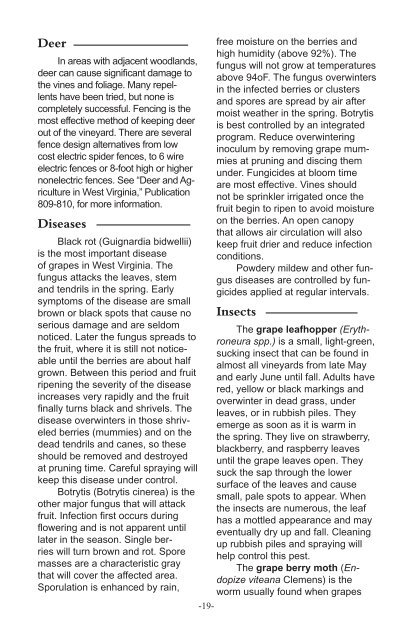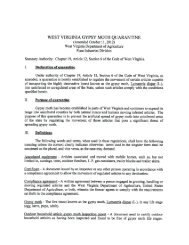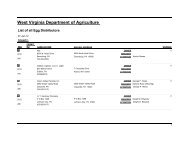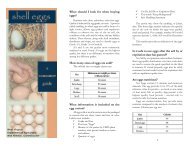Growing Grapes in WV - West Virginia Department of Agriculture
Growing Grapes in WV - West Virginia Department of Agriculture
Growing Grapes in WV - West Virginia Department of Agriculture
Create successful ePaper yourself
Turn your PDF publications into a flip-book with our unique Google optimized e-Paper software.
DeerIn areas with adjacent woodlands,deer can cause significant damage tothe v<strong>in</strong>es and foliage. Many repellentshave been tried, but none iscompletely successful. Fenc<strong>in</strong>g is themost effective method <strong>of</strong> keep<strong>in</strong>g deerout <strong>of</strong> the v<strong>in</strong>eyard. There are severalfence design alternatives from lowcost electric spider fences, to 6 wireelectric fences or 8-foot high or highernonelectric fences. See “Deer and <strong>Agriculture</strong><strong>in</strong> <strong>West</strong> Virg<strong>in</strong>ia,” Publication809-810, for more <strong>in</strong>formation.DiseasesBlack rot (Guignardia bidwellii)is the most important disease<strong>of</strong> grapes <strong>in</strong> <strong>West</strong> Virg<strong>in</strong>ia. Thefungus attacks the leaves, stemand tendrils <strong>in</strong> the spr<strong>in</strong>g. Earlysymptoms <strong>of</strong> the disease are smallbrown or black spots that cause noserious damage and are seldomnoticed. Later the fungus spreads tothe fruit, where it is still not noticeableuntil the berries are about halfgrown. Between this period and fruitripen<strong>in</strong>g the severity <strong>of</strong> the disease<strong>in</strong>creases very rapidly and the fruitf<strong>in</strong>ally turns black and shrivels. Thedisease overw<strong>in</strong>ters <strong>in</strong> those shriveledberries (mummies) and on thedead tendrils and canes, so theseshould be removed and destroyedat prun<strong>in</strong>g time. Careful spray<strong>in</strong>g willkeep this disease under control.Botrytis (Botrytis c<strong>in</strong>erea) is theother major fungus that will attackfruit. Infection first occurs dur<strong>in</strong>gflower<strong>in</strong>g and is not apparent untillater <strong>in</strong> the season. S<strong>in</strong>gle berrieswill turn brown and rot. Sporemasses are a characteristic graythat will cover the affected area.Sporulation is enhanced by ra<strong>in</strong>,-19-free moisture on the berries andhigh humidity (above 92%). Thefungus will not grow at temperaturesabove 94oF. The fungus overw<strong>in</strong>ters<strong>in</strong> the <strong>in</strong>fected berries or clustersand spores are spread by air aftermoist weather <strong>in</strong> the spr<strong>in</strong>g. Botrytisis best controlled by an <strong>in</strong>tegratedprogram. Reduce overw<strong>in</strong>ter<strong>in</strong>g<strong>in</strong>oculum by remov<strong>in</strong>g grape mummiesat prun<strong>in</strong>g and disc<strong>in</strong>g themunder. Fungicides at bloom timeare most effective. V<strong>in</strong>es shouldnot be spr<strong>in</strong>kler irrigated once thefruit beg<strong>in</strong> to ripen to avoid moistureon the berries. An open canopythat allows air circulation will alsokeep fruit drier and reduce <strong>in</strong>fectionconditions.Powdery mildew and other fungusdiseases are controlled by fungicidesapplied at regular <strong>in</strong>tervals.InsectsThe grape leafhopper (Erythroneuraspp.) is a small, light-green,suck<strong>in</strong>g <strong>in</strong>sect that can be found <strong>in</strong>almost all v<strong>in</strong>eyards from late Mayand early June until fall. Adults havered, yellow or black mark<strong>in</strong>gs andoverw<strong>in</strong>ter <strong>in</strong> dead grass, underleaves, or <strong>in</strong> rubbish piles. Theyemerge as soon as it is warm <strong>in</strong>the spr<strong>in</strong>g. They live on strawberry,blackberry, and raspberry leavesuntil the grape leaves open. Theysuck the sap through the lowersurface <strong>of</strong> the leaves and causesmall, pale spots to appear. Whenthe <strong>in</strong>sects are numerous, the leafhas a mottled appearance and mayeventually dry up and fall. Clean<strong>in</strong>gup rubbish piles and spray<strong>in</strong>g willhelp control this pest.The grape berry moth (Endopizeviteana Clemens) is theworm usually found when grapes

















